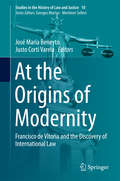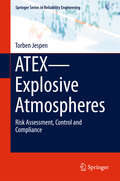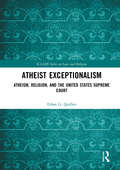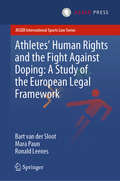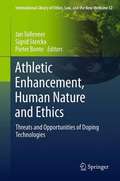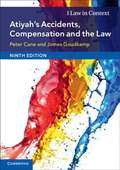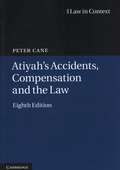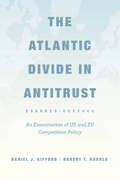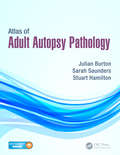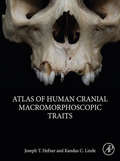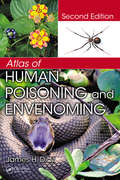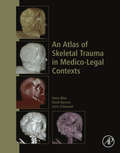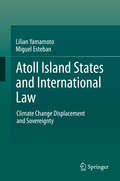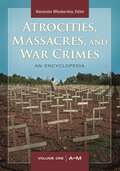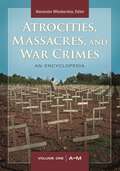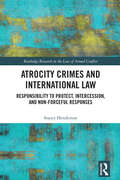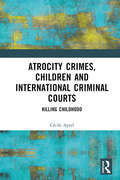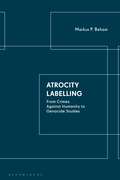- Table View
- List View
At the Origins of Modernity: Francisco de Vitoria and the Discovery of International Law (Studies in the History of Law and Justice #10)
by José María Beneyto Justo Corti VarelaThis book is based on an international project conducted by the Institute for European Studies of the University CEU San Pablo in Madrid and a seminar on Vitoria and International Law which took place on July 2nd 2015 in the convent of San Esteban, the place where Vitoria spent his most productive years as Chair of Theology at the University of Salamanca. It argues that Vitoria not only lived at a time bridging the Middle Ages and Modernity, but also that his thoughts went beyond the times he lived in, giving us inspiration for meeting current challenges that could also be described as “modern” or even post-modern.There has been renewed interest in Francisco de Vitoria in the last few years, and he is now at the centre of a debate on such central international topics as political modernity, colonialism, the discovery of the “Other” and the legitimation of military interventions. All these subjects include Vitoria’s contributions to the formation of the idea of modernity and modern international law.The book explores two concepts of modernity: one referring to the post-medieval ages and the other to our times. It discusses the connections between the challenges that the New World posed for XVIth century thinkers and those that we are currently facing, for example those related to the cyberworld. It also addresses the idea of international law and the legitimation of the use of force, two concepts that are at the core of Vitoria’s texts, in the context of “modern” problems related to a multipolar world and the war against terrorism. This is not a historical book on Vitoria, but a very current one that argues the value of Vitoria’s reflections for contemporary issues of international law.
ATEX—Explosive Atmospheres: Risk Assessment, Control and Compliance (Springer Series in Reliability Engineering)
by Torben JespenThis book details how safety (i.e. the absence of unacceptable risks) is ensured in areas where potentially explosive atmospheres (ATEX) can arise. The book also offers readers essential information on how to comply with the newest (April 2016) EU legislation when the presence of ATEX cannot be avoided. By presenting general guidance on issues arising out of the EU ATEX legislation – especially on zone classification, explosion risk assessment, equipment categorization, Ex-marking and related technical/chemical aspects – the book provides equipment manufacturers, responsible employers, and others with the essential knowledge they need to be able to understand the different – and often complicated – aspects of ATEX and to implement the necessary safety precautions. As such, it represents a valuable resource for all those concerned with maintaining high levels of safety in ATEX environments.
Atheist Exceptionalism: Atheism, Religion, and the United States Supreme Court (ICLARS Series on Law and Religion)
by Ethan G. QuillenDue to its Constitution, and particularly to that Constitution’s First Amendment, the relationship between religion and politics in the United States is rather unusual. This is especially the case concerning the manner with which religious terminology is defined via the discourse adopted by the United States Supreme Court, and the larger American judicial system. Focusing on the religious term of Atheism, this book presents both the discourse itself, in the form of case decisions, as well as an analysis of that discourse. The work thus provides an essential introduction and discussion of both Atheism as a concept and the influence that judicial decisions have on the way we perceive the meaning of religious terminology in a national context. As a singular source on the Supreme, Circuit, and District Court cases concerning Atheism and its judicial definition, the book offers convenient access to this discourse for researchers and students. The discursive analysis further provides an original theoretical insight into how the term ‘Atheism’ has been judicially defined. As such, it will be a valuable resource for scholars of religion and law, as well as those interested in the definition and study of Atheism.
Atheist Exceptionalism: Atheism, Religion, and the United States Supreme Court (ICLARS Series on Law and Religion)
by Ethan G. QuillenDue to its Constitution, and particularly to that Constitution’s First Amendment, the relationship between religion and politics in the United States is rather unusual. This is especially the case concerning the manner with which religious terminology is defined via the discourse adopted by the United States Supreme Court, and the larger American judicial system. Focusing on the religious term of Atheism, this book presents both the discourse itself, in the form of case decisions, as well as an analysis of that discourse. The work thus provides an essential introduction and discussion of both Atheism as a concept and the influence that judicial decisions have on the way we perceive the meaning of religious terminology in a national context. As a singular source on the Supreme, Circuit, and District Court cases concerning Atheism and its judicial definition, the book offers convenient access to this discourse for researchers and students. The discursive analysis further provides an original theoretical insight into how the term ‘Atheism’ has been judicially defined. As such, it will be a valuable resource for scholars of religion and law, as well as those interested in the definition and study of Atheism.
Athletes’ Human Rights and the Fight Against Doping: A Study of the European Legal Framework (ASSER International Sports Law Series)
by Bart van der Sloot Mara Paun Ronald LeenesThis book addresses the tension between, on the one hand, anti-doping practices and measures and, on the other hand, the fundamental rights of athletes. New techniques for testing and re-testing samples taken several years ago, have caused a push by the World Anti-Doping Agency and affiliated organizations for stricter rules, more doping tests and higher sanctions. Meanwhile, many States are adopting new laws and regulations to facilitate this push. At the same time, privacy and data protection have gained new momentum, especially in the European Union, where the General Data Protection Regulation came into effect in May 2018. It contains new obligations for data controllers and processors, rights for data subjects and sanctions for those violating the data protection rules. It is clear that gathering whereabouts information on athletes, collecting urine and blood samples, analyzing the samples and using the data distilled there from falls within the scope of the data protection framework. In addition, European athletes can invoke their rights to privacy, fair trial and freedom from discrimination as guaranteed by the European Convention on Human Rights. The book is aimed at professionals and organizations involved in sports and anti-doping and provides them with an opportunity to delve into and understand the rights guaranteed to athletes within the European context. Furthermore, it is equally relevant for privacy and data protection lawyers and human rights scholars wishing to familiarize themselves with the difficult questions relating to human rights protection in the world of sport and anti-doping. Written in accessible language, it should also prove useful to athletes and laymen wanting to learn about the rules applicable to almost everyone who practices sport, even at a local amateur level. Bart van der Sloot is senior researcher at Tilburg University, Tilburg, The Netherlands, Mara Paun is PhD researcher at Tilburg University, Tilburg, The Netherlands, Ronald Leenes is professor at Tilburg University, Tilburg, The Netherlands.
Athletic Enhancement, Human Nature and Ethics: Threats and Opportunities of Doping Technologies (International Library of Ethics, Law, and the New Medicine #52)
by Jan Tolleneer Sigrid Sterckx Pieter BonteThe book provides an in-depth discussion on the human nature concept from different perspectives and from different disciplines, analyzing its use in the doping debate and researching its normative overtones. The relation between natural talent and enhanced abilities is scrutinized within a proper conceptual and theoretical framework: is doping to be seen as a factor of the athlete’s dehumanization or is it a tool to fulfill his/her aspirations to go faster, higher and stronger? Which characteristics make sports such a peculiar subject of ethical discussion and what are the, both intrinsic and extrinsic, moral dangers and opportunities involved in athletic enhancement? This volume combines fundamental philosophical anthropological reflection with applied ethics and socio-cultural and empirical approaches. Furthermore guidelines will be presented to decision- and policy-makers on local, national and international levels. Zooming in on the intrinsic issue of what is valuable about our homo sapiens biological condition, this volume devotes only scant attention to the specific issue of natural talent and why such talent is appreciated so differently than biotechnological origins of ability. In addition, specific aspects of sports such as its competitive nature and its direct display of bodily prowess provide good reason to single out the issue of natural athletic talent for sustained ethical scrutiny.
Atiyah's Accidents: Compensation and the Law (9th Edition) (PDF)
by Peter Cane James GoudkampNow in its ninth edition, Atiyah’s Accidents, Compensation and the Law explores the recent and continuous developments in personal injury law by applying social context to the relevant legal principles. Those principles remain in need of radical reform. Updates to the text include discussion of the major changes to the way compensation is calculated and claimed, evolving funding arrangements for personal injury litigation, and dramatic shifts in the claims management industry. Suitable for both undergraduate and postgraduate students taking courses in tort law, this new edition balances theory, practice and context. It draws on new legislation, research
Atiyah's Accidents, Compensation And The Law (PDF)
by Peter Cane Patrick AtiyahSince publication of the seventh edition of this seminal text, personal injury law has witnessed momentous changes. A major overhaul of the social security system began in 2012 and the Equality Act 2010 significantly modifies anti-discrimination law and its impact on the disabled. But perhaps the most important legal developments have affected the financing and conduct of personal injury claiming and the operation of the claims-management industry. This new edition takes account of all this activity while setting it into a wider and longer perspective. Complaints that Britain is a 'compensation culture' and that the tort system is out of control are explained and assessed and options for further change are explored. Through the turmoil and controversy, the tort system remains a central feature of the legal and social landscape. The book's enduring central argument for its radical reform remains as compelling as ever.
The Atlantic Divide in Antitrust: An Examination of US and EU Competition Policy
by Daniel J. Gifford Robert T. KudrleHow is it that two broadly similar systems of competition law have reached different results across a number of significant antitrust issues? While the United States and the European Union share a commitment to maintaining competition in the marketplace and employ similar concepts and legal language in making antitrust decisions, differences in social values, political institutions, and legal precedent have inhibited close convergence. With The Atlantic Divide in Antitrust, Daniel J. Gifford and Robert T. Kudrle explore many of the main contested areas of contemporary antitrust, including mergers, price discrimination, predatory pricing, and intellectual property. After identifying how prevailing analyses differ across these areas, they then examine the policy ramifications. Several themes run throughout the book, including differences in the amount of discretion firms have in dealing with purchasers, the weight given to the welfare of various market participants, and whether competition tends to be viewed as an efficiency-generating process or as rivalry. The authors conclude with forecasts and suggestions for how greater compatibility might ultimately be attained.
The Atlantic Divide in Antitrust: An Examination of US and EU Competition Policy
by Daniel J. Gifford Robert T. KudrleHow is it that two broadly similar systems of competition law have reached different results across a number of significant antitrust issues? While the United States and the European Union share a commitment to maintaining competition in the marketplace and employ similar concepts and legal language in making antitrust decisions, differences in social values, political institutions, and legal precedent have inhibited close convergence. With The Atlantic Divide in Antitrust, Daniel J. Gifford and Robert T. Kudrle explore many of the main contested areas of contemporary antitrust, including mergers, price discrimination, predatory pricing, and intellectual property. After identifying how prevailing analyses differ across these areas, they then examine the policy ramifications. Several themes run throughout the book, including differences in the amount of discretion firms have in dealing with purchasers, the weight given to the welfare of various market participants, and whether competition tends to be viewed as an efficiency-generating process or as rivalry. The authors conclude with forecasts and suggestions for how greater compatibility might ultimately be attained.
The Atlantic Divide in Antitrust: An Examination of US and EU Competition Policy
by Daniel J. Gifford Robert T. KudrleHow is it that two broadly similar systems of competition law have reached different results across a number of significant antitrust issues? While the United States and the European Union share a commitment to maintaining competition in the marketplace and employ similar concepts and legal language in making antitrust decisions, differences in social values, political institutions, and legal precedent have inhibited close convergence. With The Atlantic Divide in Antitrust, Daniel J. Gifford and Robert T. Kudrle explore many of the main contested areas of contemporary antitrust, including mergers, price discrimination, predatory pricing, and intellectual property. After identifying how prevailing analyses differ across these areas, they then examine the policy ramifications. Several themes run throughout the book, including differences in the amount of discretion firms have in dealing with purchasers, the weight given to the welfare of various market participants, and whether competition tends to be viewed as an efficiency-generating process or as rivalry. The authors conclude with forecasts and suggestions for how greater compatibility might ultimately be attained.
The Atlantic Divide in Antitrust: An Examination of US and EU Competition Policy
by Daniel J. Gifford Robert T. KudrleHow is it that two broadly similar systems of competition law have reached different results across a number of significant antitrust issues? While the United States and the European Union share a commitment to maintaining competition in the marketplace and employ similar concepts and legal language in making antitrust decisions, differences in social values, political institutions, and legal precedent have inhibited close convergence. With The Atlantic Divide in Antitrust, Daniel J. Gifford and Robert T. Kudrle explore many of the main contested areas of contemporary antitrust, including mergers, price discrimination, predatory pricing, and intellectual property. After identifying how prevailing analyses differ across these areas, they then examine the policy ramifications. Several themes run throughout the book, including differences in the amount of discretion firms have in dealing with purchasers, the weight given to the welfare of various market participants, and whether competition tends to be viewed as an efficiency-generating process or as rivalry. The authors conclude with forecasts and suggestions for how greater compatibility might ultimately be attained.
Atlas of Adult Autopsy Pathology
by Julian Burton Sarah Saunders Stuart HamiltonThe Atlas of Adult Autopsy Pathology is a full-color atlas for those performing, or learning to perform, adult autopsies. It is arranged by organ systems and also includes chapters on external examination findings, the effect of decomposition, and histopathological findings, as well as procedures and devices one may encounter during autopsy.The boo
Atlas of Human Cranial Macromorphoscopic Traits
by Joseph T. Hefner Kandus C. LindeAtlas of Human Cranial Macromorphoscopic Traits synthesizes macromorphoscopic traits and their analysis in an accessible manner, providing detailed descriptions and examples of the various character state manifestations intended for use in classrooms, laboratories, and in the field. The volume begins with an outline of the macromorphoscopic dataset, its history, recent modifications to the historical approach, and recent technological and analytical advances. Additional sections cover Nomenclature, Gross Anatomy, Function, Methodology, Line Drawings, Detailed Definitions, Multiple High-resolution Photographs, and Population Variation Data from the Macromorphoscopic Databank (MaMD). The volume concludes with a chapter outlining the statistical analysis of macromorphoscopic data and a summary of the computer programs and reference databases available to forensic anthropologists for the analysis of these data.Provides detailed descriptions, illustrations and high-resolution images of various character state manifestations of seventeen macromorphoscopic traitsApplies to both forensic and bioarcheological researchWritten by the foremost expert on macromorphoscopic trait analysis and estimation of ancestry in forensic anthropology
Atlas of Human Poisoning and Envenoming
by James H. DiazClinicians undergoing competency testing, certification, and periodic recertification are frequently faced with computer-based exams designed to evaluate clinical acumen and judgment. Test questions often include an image or radiograph followed by a vignette of the clinical encounter and a series of questions. Designed to better prepare practitione
An Atlas of Skeletal Trauma in Medico-Legal Contexts
by Soren Blau David Ranson Chris O'DonnellPost-mortem computed tomography (PMCT) is increasingly used in forensic pathology practice in many jurisdictions. Such imaging has expanded the capacity to evaluate skeletal trauma improving the visualisation, documentation and presentation of forensic findings. Typically when deceased persons are located and exhibit evidence of trauma, forensic pathologist, anthropologists and radiologists base their interpretations of the mechanism of trauma on their experience and understanding of the biomechanics of fractures as well as recognisable patterns of injury. In order to augment this process, An Atlas of Forensic Skeletal Trauma presents a range of de-identified adult and child skeletal trauma cases that occur in medico-legal contexts where the cause of death and mechanism of trauma are recorded. An Atlas of Forensic Skeletal Trauma includes comprehensive photographs and PMCT images as well as descriptive text.Presents a valuable guide to the interpretation of skeletal trauma for practitioners and students of forensic anthropology, pathology and radiologyProvides coverage of skeletal trauma cases resulting from high and low velocity projectiles, low energy blunt force (e.g., assaults involving various implements, hangings, strangulations, falls), high energy blunt force (e.g., motor vehicle and aviation incidents), and moreIncludes case studies with written and visual descriptions, discussions and up-to-date literature review
Atoll Island States and International Law: Climate Change Displacement and Sovereignty
by Lilian Yamamoto Miguel EstebanAtoll Island States exist on top of what is perceived to be one of the planet's most vulnerable ecosystems: atolls. It has been predicted that an increase in the pace of sea level rise brought about by increasing greenhouse gas concentrations in the atmosphere will cause them to disappear, forcing their inhabitants to migrate. The present book represents a multidisciplinary legal and engineering perspective on this problem, challenging some common misconceptions regarding atolls and their vulnerability to sea-level rise. Coral islands have survived past changes in sea levels, and it is the survival of coral reefs what will be crucial for their continued existence. These islands are important for their inhabitants as they represent not only their ancestral agricultural lands and heritage, but also a source of revenue through the exploitation of the maritime areas associated with them. However, even if faced with extreme climate change, it could theoretically be possible for the richer Atoll Island States to engineer ways to prevent their main islands from disappearing, though sadly not all will have the required financial resources to do so. As islands become progressively uninhabitable their residents will be forced to settle in foreign lands, and could become stateless if the Atoll Island State ceases to be recognized as a sovereign country. However, rather than tackling this problem by entering into lengthy negotiations over new treaties, more practical solutions, encompassing bilateral negotiations or the possibility of acquiring small new territories, should be explored. This would make it possible for Atoll Island States in the future to keep some sort of international sovereign personality, which could benefit the descendents of its present day inhabitants.
Atrocities, Massacres, and War Crimes [2 volumes] [2 volumes]: 2 volumes [2 volumes]
by Alexander MikaberidzeBoth concise and wide-ranging, this encyclopedia covers massacres, atrocities, war crimes, and genocides, including acts of inhumanity on all continents; and serves as a reminder that lest we forget, history will repeat itself.The 400-plus entries in Atrocities, Massacres, and War Crimes: An Encyclopedia provide accessible and concise information on the difficult subject of abject human violence committed on all continents. The entries in this two-volume work describe atrocities, massacres, and war crimes committed in the 20th century, thereby documenting how human beings have repeatedly proven their capability to commit horrific acts of inhumanity even in relatively recent times and within the modern era. The encyclopedia covers countries, treaties, and terms; profiles individuals who had been formally indicted for war crimes as well as those who have committed mass atrocities and gone unpunished; and addresses human rights violations, crimes against humanity, and crimes against peace.
Atrocities, Massacres, and War Crimes [2 volumes] [2 volumes]: 2 volumes [2 volumes]
Both concise and wide-ranging, this encyclopedia covers massacres, atrocities, war crimes, and genocides, including acts of inhumanity on all continents; and serves as a reminder that lest we forget, history will repeat itself.The 400-plus entries in Atrocities, Massacres, and War Crimes: An Encyclopedia provide accessible and concise information on the difficult subject of abject human violence committed on all continents. The entries in this two-volume work describe atrocities, massacres, and war crimes committed in the 20th century, thereby documenting how human beings have repeatedly proven their capability to commit horrific acts of inhumanity even in relatively recent times and within the modern era. The encyclopedia covers countries, treaties, and terms; profiles individuals who had been formally indicted for war crimes as well as those who have committed mass atrocities and gone unpunished; and addresses human rights violations, crimes against humanity, and crimes against peace.
Atrocity Crimes and International Law: Responsibility to Protect, Intercession, and Non-Forceful Responses (Routledge Research in the Law of Armed Conflict)
by Stacey HendersonDespite repeated declarations of ‘never again’ in response to the commission of atrocities, civilians have continued to be targeted by their leaders and opposition groups. The international law principles of sovereignty and non-intervention, when taken at their highest, require States to stand idle and not intervene in another State regardless of what atrocities may be occurring there. This traditional legal view is being challenged by an emerging practice of States choosing to respond in non-forceful ways, inspired by the concept of the Responsibility to Protect (R2P). Drawing on R2P, this book introduces and develops an original conceptual tool –intercession –to capture and explain this change in State practice and the impact of R2P on the development of international law. Through a close examination of State practice, the work explores whether there has been an expansion in the permissible measures and situations in which States can intervene, without using force, in response to atrocity crimes occurring in other States. This book concludes that the development of the secondary duty on the international community under R2P provides the greatest opportunity to progress the R2P framework in a meaningful way, which will have a significant impact on the protection of populations from atrocity crimes. The book will be essential reading for students, researchers and policymakers working in the areas of international law, international relations, humanitarian law, and peace and security studies.
Atrocity Crimes and International Law: Responsibility to Protect, Intercession, and Non-Forceful Responses (Routledge Research in the Law of Armed Conflict)
by Stacey HendersonDespite repeated declarations of ‘never again’ in response to the commission of atrocities, civilians have continued to be targeted by their leaders and opposition groups. The international law principles of sovereignty and non-intervention, when taken at their highest, require States to stand idle and not intervene in another State regardless of what atrocities may be occurring there. This traditional legal view is being challenged by an emerging practice of States choosing to respond in non-forceful ways, inspired by the concept of the Responsibility to Protect (R2P). Drawing on R2P, this book introduces and develops an original conceptual tool –intercession –to capture and explain this change in State practice and the impact of R2P on the development of international law. Through a close examination of State practice, the work explores whether there has been an expansion in the permissible measures and situations in which States can intervene, without using force, in response to atrocity crimes occurring in other States. This book concludes that the development of the secondary duty on the international community under R2P provides the greatest opportunity to progress the R2P framework in a meaningful way, which will have a significant impact on the protection of populations from atrocity crimes. The book will be essential reading for students, researchers and policymakers working in the areas of international law, international relations, humanitarian law, and peace and security studies.
Atrocity Crimes, Children and International Criminal Courts: Killing Childhood
by Cécile AptelThis book shows how international criminal courts have paid only limited and inconsistent attention to atrocity crimes affecting children. It elucidates the many structural, legal, financial and even attitudinal obstacles, often overlapping, that have contributed to the international courts’ focus on the experience of adults, rendering children almost invisible. It reviews whether and how different international and hybrid criminal jurisdictions have considered international crimes committed against or by children. The book also considers how international criminal justice can help contribute to the recognition of the specific impact that international crimes have on children, whether as victims or as participants, and strengthen their protection. Finally, it proposes an agenda to improve this situation, making specific recommendations encompassing the urgent need to further elaborate child-friendly procedures. It also calls for international investigative and prosecutorial strategies to be less adult-centric and broaden the scope of crimes against children beyond the focus on child-soldiers. This book is an invaluable resource for academics, researchers and fieldworkers in the areas of international criminal law, international human rights law/child rights, international humanitarian law, child protection and transitional justice.
Atrocity Crimes, Children and International Criminal Courts: Killing Childhood
by Cécile AptelThis book shows how international criminal courts have paid only limited and inconsistent attention to atrocity crimes affecting children. It elucidates the many structural, legal, financial and even attitudinal obstacles, often overlapping, that have contributed to the international courts’ focus on the experience of adults, rendering children almost invisible. It reviews whether and how different international and hybrid criminal jurisdictions have considered international crimes committed against or by children. The book also considers how international criminal justice can help contribute to the recognition of the specific impact that international crimes have on children, whether as victims or as participants, and strengthen their protection. Finally, it proposes an agenda to improve this situation, making specific recommendations encompassing the urgent need to further elaborate child-friendly procedures. It also calls for international investigative and prosecutorial strategies to be less adult-centric and broaden the scope of crimes against children beyond the focus on child-soldiers. This book is an invaluable resource for academics, researchers and fieldworkers in the areas of international criminal law, international human rights law/child rights, international humanitarian law, child protection and transitional justice.
Atrocity Labelling: From Crimes Against Humanity to Genocide Studies
by Markus P. BehamAtrocity. Genocide. War crime. Crime Against Humanity. Such atrocity labels have been popularized among international lawmakers but with little insight offered into how and when these terms are applied and to what effect. What constitutes an event to be termed a genocide or war crime and what role does this play in the application of legal proceedings?Markus P. Beham, through an interdisciplinary and comparative approach, unpicks these terms to uncover their historical genesis and their implications for international criminal law initiatives concerned with atrocity. The book uniquely compares four specific case studies: Belgian colonial exploitation of the Congo, atrocities committed against the Herero and Nama in German South-West Africa, the Armenian genocide and the man-made Ukrainian famine of the 1930s. Encompassing international law, legal history, and discourse analysis, the concept of 'atrocity labelling' is used to capture the meaning underlying the work of international lawyers and prosecutors, historians and sociologists, agenda setters and policy makers.
Atrocity Labelling: From Crimes Against Humanity to Genocide Studies
by Markus P. BehamAtrocity. Genocide. War crime. Crime Against Humanity. Such atrocity labels have been popularized among international lawmakers but with little insight offered into how and when these terms are applied and to what effect. What constitutes an event to be termed a genocide or war crime and what role does this play in the application of legal proceedings?Markus P. Beham, through an interdisciplinary and comparative approach, unpicks these terms to uncover their historical genesis and their implications for international criminal law initiatives concerned with atrocity. The book uniquely compares four specific case studies: Belgian colonial exploitation of the Congo, atrocities committed against the Herero and Nama in German South-West Africa, the Armenian genocide and the man-made Ukrainian famine of the 1930s. Encompassing international law, legal history, and discourse analysis, the concept of 'atrocity labelling' is used to capture the meaning underlying the work of international lawyers and prosecutors, historians and sociologists, agenda setters and policy makers.
